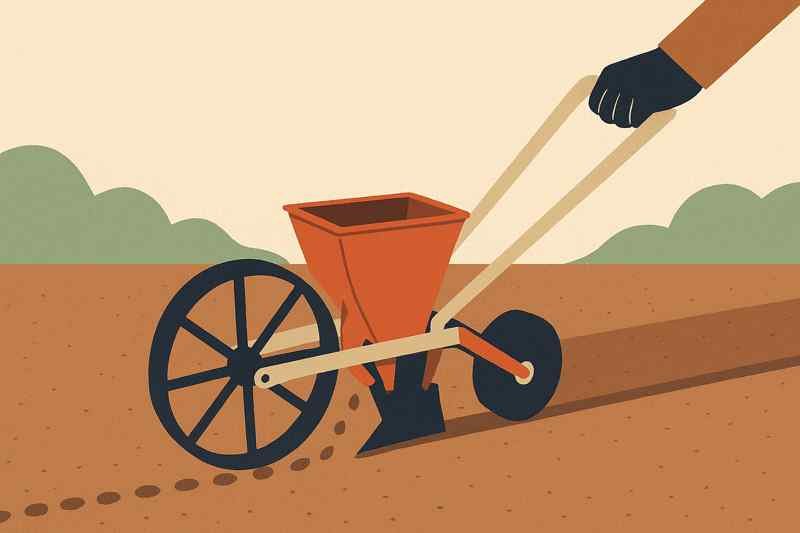Rethinking Precision in Planting
In an era where agricultural innovation often involves drones, AI, and big data, manual seeder tools may seem outdated. However, for smallholder farmers, urban gardeners, and low-resource agricultural operations, these hand-powered devices are essential. They’re not a step backward—they’re a practical, efficient response to the growing need for sustainable and scalable food production.
Between labor-intensive hand sowing and sophisticated mechanised seeders, manual seeders bridge a crucial gap. They provide a regulated method of evenly planting seeds without the expense of fuel, upkeep, or complexity of larger machinery. The outcome? Better crop spacing, decreased seed waste, and increased production potential—all without going over budget.
What is a Manual Seeder Tool?
A manual seeder is a handheld or wheeled device designed to plant seeds directly into soil at uniform depth and spacing. There are many types, ranging from single-row jab planters to multi-row wheeled seeders. What unites them is simplicity—no electricity, no engines, just mechanical action and human power.
Most manual seeders have:
- A hopper or seed chamber
- A metering system for consistent seed drop
- A furrow opener
- A mechanism to cover the seed
Manual seeders are typically designed to plant crops like maize, beans, soy, millet, and vegetables, depending on the seed plate or system used.
Who Uses Them, and Why?
Manual seeders are especially useful in places where access to heavy machinery is limited or impractical. Small-scale farmers in Africa, South Asia, and Latin America have adopted these tools not because they reject technology, but because they require tools that match their reality.
Urban agriculture projects, community gardens, and regenerative farms also benefit from manual seeders. Their low cost and easy maintenance make them perfect for experimentation, seasonal planting, or educational farming projects.
Beyond economics, manual seeders offer something powerful: autonomy. Farmers aren’t tied to fuel prices, electrical power, or repair parts from overseas. With basic training, anyone can operate and maintain a manual seeder effectively.
Efficiency Without Electricity
Let’s examine why these low-tech instruments are still important. They significantly lower the amount of work needed for sowing, to start. Compared to traditional hand sowing, farmers reported a 65% reduction in planting time in field experiments conducted throughout East Africa. In addition to saving labour, this guarantees that planting can take place during the best windows, which is essential for rain-fed farming systems.
Secondly, they increase the precision of planting. Higher yields and better plant stands result from seeds germinating under identical conditions due to uniform depth and spacing. This goes beyond theory. A 2023 study conducted by the International Crops Research Institute for the Semi-Arid Tropics (ICRISAT) found that hand seeders increased sorghum yields on smallholder farms by 12%.
And third, these tools reduce seed wastage. Sowing by hand is prone to clumping and overseeding, especially for small seeds. Manual seeders meter seed flow precisely, avoiding both over- and under-planting.
Types of Manual Seeder Tools
The market now includes a surprising range of manual seeders, adapted to different needs and crops.
Jab Planters
Jab planters are simple, handheld tools with two long handles and a pointed end. You “jab” the planter into the soil, and it drops seeds at a preset depth. These are ideal for maize, beans, and soybeans, especially in hilly or uneven terrain.
Wheeled Seeders
Wheeled seeders have a rolling mechanism that opens the furrow, drops the seed, and covers it in one motion. They’re better for flat, prepared beds and can be adjusted for row spacing and seed size. Some models offer interchangeable seed plates or belt systems to handle different crops.
Multi-row Hand Push Seeders
These are broader versions with multiple furrow openers, allowing two or more rows to be planted simultaneously. While heavier, they’re great for high-density planting like onions or leafy greens.
Buy The Best Manual Seeder Machine is a vital step for farmers who want control over their planting while staying off the grid. A well-made seeder can last years with proper care, making it one of the smartest investments for small-scale agriculture.
The Unseen Impact of Seed Placement
Tractors and satellites are not the only things that require precision. The slightest features, such as the distance between seeds or their depth of burial, can have a significant impact on agricultural yield. Standardising those details is aided by manual seeders. Better row delineation leads to easier weeding, less thinning, and more consistent germination.
This degree of control can result in substantial savings for high-value crops like spinach, carrots, and lettuce. There will be fewer inputs later on if fewer seeds are discarded. That matters in a global market where input costs are skyrocketing.
Simplicity is Scalable
It’s simple to believe that modest tools will have little effect. However, this is frequently not the case. Government extension programs in nations like India are embracing low-tech solutions, such as manual seeders, because they increase production without requiring costly infrastructure or subsidies.
Their flexibility is what allows them to scale. It is possible to adapt manual seeders to local planting patterns, soil types, and seed sizes. Without importing anything, local workshops can train farmers, fix gadgets, and produce parts. These strategies have an impact in agricultural ecosystems where resilience is based on independence.
“Smallholder farmers are not just feeding their families—they’re feeding the world. Tools that empower them are tools that shape the future.”
Comparing Manual Seeders to Mechanical Seeders
Mechanical seeders provide GPS-level accuracy and are quicker. However, they need frequent maintenance, technical know-how, fuel, and calibration. One malfunction can cause a small farm to miss planting by days or even weeks.
Conversely, manual seeders don’t stall. They don’t require imported components or software upgrades. When you need them, they function. And their combined effect is enormous when multiplied across thousands of farms.
External Tools and Research
Platforms like ECHOcommunity provide tool libraries and user reviews, particularly for small-scale and tropical agriculture, for individuals who want to test various seeders before making an investment.
Low-tech solutions can contribute to better agricultural systems, according to research from the CGIAR Platform for Big Data in Agriculture. Even small farms can get insight into data-driven decision-making by recording and analysing data gathered from manual seeders, such as planting density and spacing.
FAQs
- Are manual seeders only for rural or developing areas?
Not at all. Urban gardeners, educational farms, and small commercial plots in developed countries use them too. They’re efficient, eco-friendly, and don’t need fuel or power. - How long does a manual seeder last?
With proper care and storage, a well-built manual seeder can last several seasons. Most parts can be repaired or replaced locally. - Can one seeder be used for different crops?
Yes, many models come with interchangeable plates or adjustable depth controls to suit various seeds. - What is the average cost?
Prices vary by type and brand, but most manual seeders range from $40 to $300, depending on complexity and features. - Do they work in heavy soils?
Some models are better suited for loose, well-prepared soil. However, jab planters and heavier wheel models can handle moderately compacted soils.
Future-Proofing Food with Old-School Tools
Future developments in farming, such as robotics, vertical farms, and synthetic fertilisers, are frequently discussed. However, sometimes the best way ahead is to look back. People who need results without waiting for a grant or generator can use manual seeder instruments since they are effective, dependable, and practical. They are not sentimental.
Farmers require instruments that can function under strain as the environment changes and supply lines become more unreliable. That demand is met by manual seeders. They serve as a link between conventional wisdom and contemporary effectiveness. They sow possibility rather than merely seeds.




